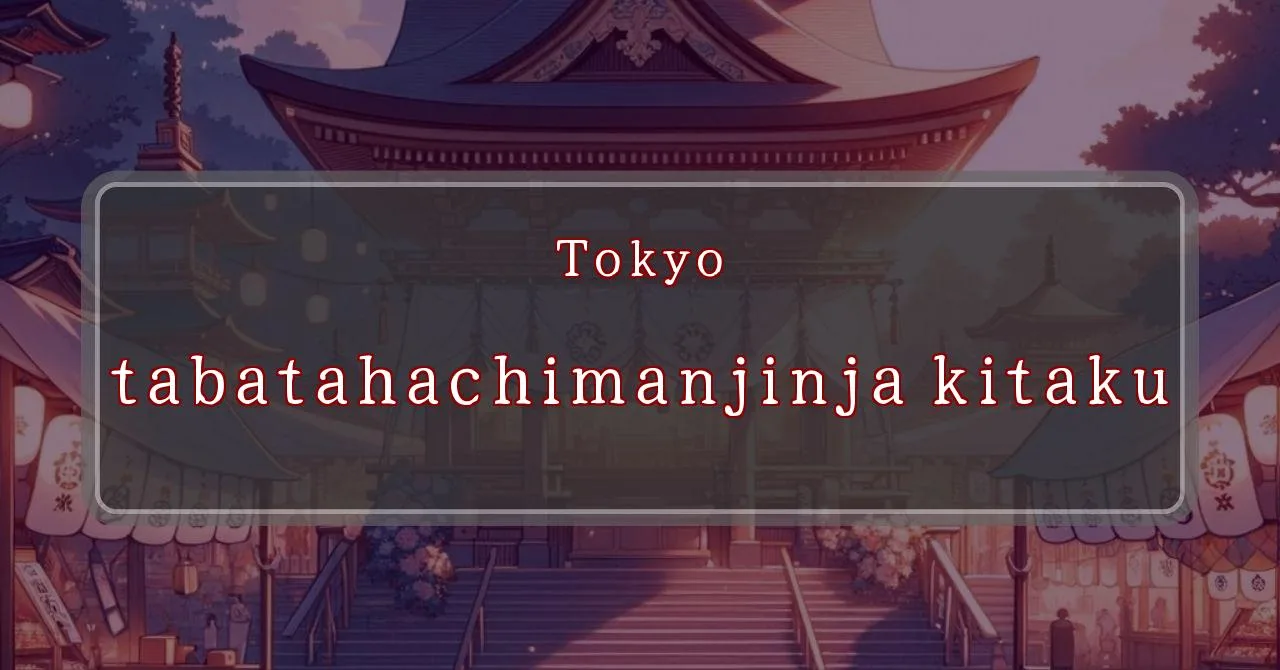Enchanting shrine festival in Tokyo with vibrant colors and lively atmosphere
Basic Information
Tabata Hachiman Shrine is a Shinto shrine located in Tabata, Kita Ward, Tokyo, Japan. It is dedicated to the deity Hachiman, the god of war and guardian of warriors.
- Address: 2-7-2 Tabata, Kita Ward, Tokyo 114-0014
- Phone Number: 03-3828-6867
- Access: 5-minute walk from JR Yamanote Line/Keihin Tohoku Line Tabata Station
- Festival Days: Saturday and Sunday closest to August 15th
Main Events and Attractions of the Festival
The Tabata Hachiman Shrine Festival is a lively and colorful event that attracts many visitors each year. The festival features a variety of events and attractions, including:
Mikoshi Procession
One of the highlights of the festival is the mikoshi procession. A mikoshi is a portable shrine that is carried through the streets by a team of people. The Tabata Hachiman Shrine mikoshi is a large and elaborate structure, and it is a sight to behold as it is carried through the streets.
- Overview: A parade of portable shrines carried through the streets
- Features: Elaborately decorated mikoshi and lively atmosphere
Shishimai Dance
Another popular attraction at the festival is the shishimai dance. Shishimai is a traditional Japanese lion dance, and it is often performed at festivals and other special events. The Tabata Hachiman Shrine shishimai dance is performed by a team of dancers who wear colorful costumes and masks.
- Overview: A traditional Japanese lion dance
- Features: Colorful costumes, energetic performance, and lively music
Kagura
Kagura is a traditional Japanese dance that is performed to Shinto music. Kagura is often performed at festivals and other religious ceremonies. The Tabata Hachiman Shrine kagura is performed by a team of dancers who wear elaborate costumes and masks.
- Overview: A sacred dance performed to Shinto music
- Features: Graceful movements, colorful costumes, and traditional music
Blessings and Deities
Tabata Hachiman Shrine is dedicated to the deity Hachiman, the god of war and guardian of warriors. Hachiman is also revered as a protector of the community and a bringer of good fortune.
- Blessings: Protection, victory, good fortune
- Deities: Hachiman
Origin and History
The origins of Tabata Hachiman Shrine are unclear, but it is believed to have been founded in the 12th century. The shrine was originally located on a hilltop, but it was moved to its current location in the 17th century. Tabata Hachiman Shrine has been a popular place of worship for centuries, and it is especially revered by local residents.
- Founded: 12th century
- Relocated: 17th century
- Significance: Popular place of worship, revered by local residents
Tips and Notes for Visitors
If you are planning to visit Tabata Hachiman Shrine, here are a few things to keep in mind:
- The shrine is open daily from 9:00 AM to 5:00 PM.
- Admission is free.
- There is a small parking lot available for visitors.
- The shrine is a popular destination for weddings and other special events.
- If you are visiting during a festival or other special event, be prepared for crowds.
Parking Information
There is a small parking lot available for visitors to Tabata Hachiman Shrine. The parking lot is located behind the shrine, and it can accommodate about 20 cars. Parking is free of charge.
- Location: Behind the shrine
- Capacity: Approximately 20 cars
- Cost: Free
Popular Stalls and Food Carts in Recent Years
| Type of Stall | Description |
|---|---|
| Takoyaki | A staple at Japanese festivals. Characterized by a crispy outside and a creamy inside. |
| Jaga Butter | A simple yet popular snack of hot potatoes lavishly topped with melted butter. |
| Baby Castella | Small castella cakes, sweet and fluffy treats enjoyed by children and adults alike. |
| Grilled Ayu with Salt | Fresh ayu fish grilled whole with salt, a savory taste of Japanese summer. |
| Shaapin | A unique gourmet item influenced by foreign cuisine, with a chewy skin wrapping the filling. |
| Okonomiyaki | A Japanese grilled dish where you often choose your own ingredients for a personalized flavor. |
| Cotton Candy | A fluffy, sweet snack that’s extremely popular with children. |
| Chocolate Banana | A banana coated in chocolate, a fun and visually appealing dessert. |
| Kushiyaki | Various types of ingredients skewered and grilled, an easy-to-enjoy snack. |
| Yakisoba | Fried noodles mixed with a special sauce, a fast food favorite in Japan. |



